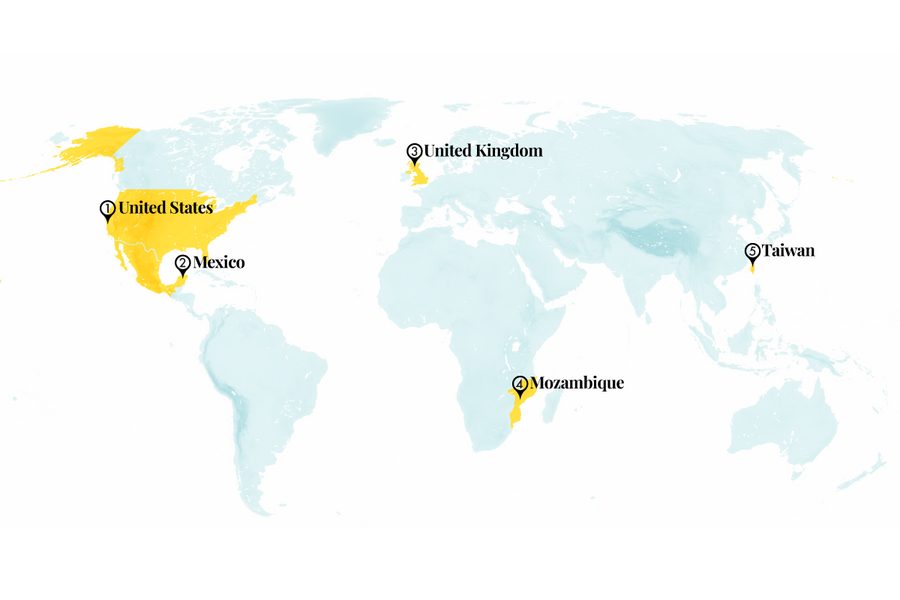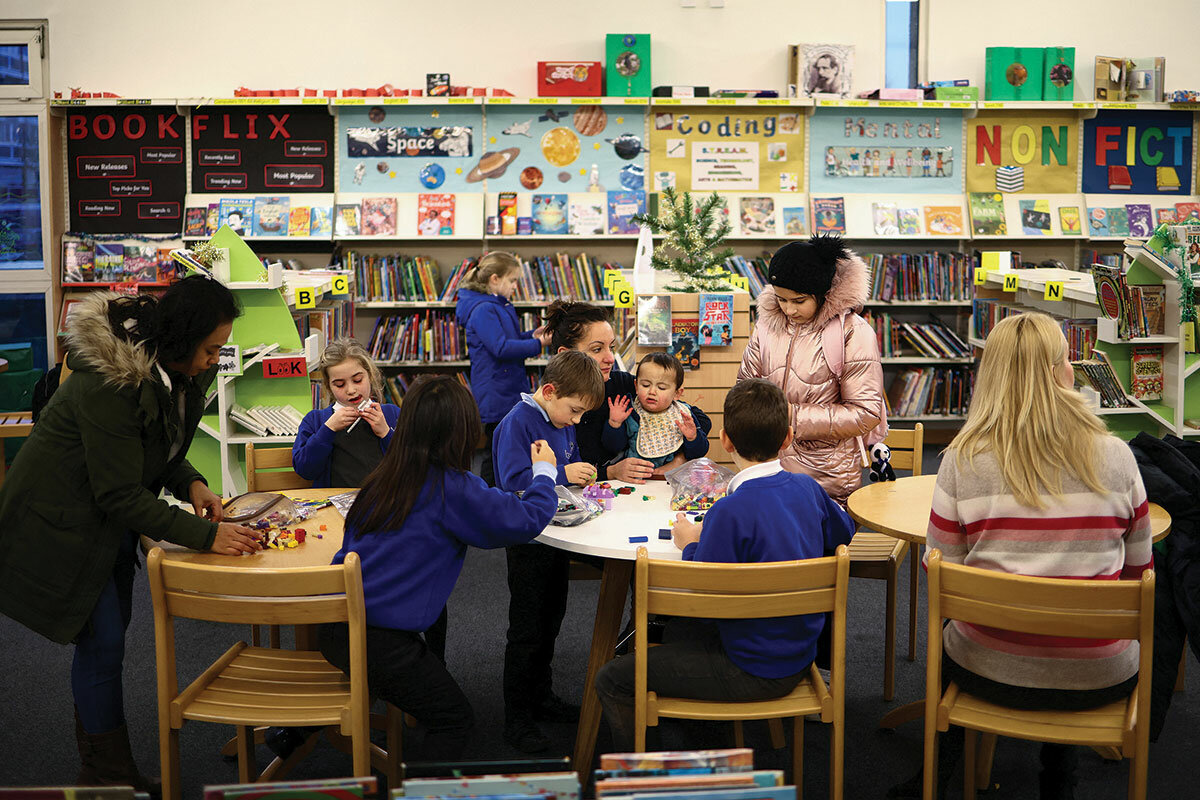A penny pincher’s park, and the libraries loaning a warm nook
Loading...
1. United States
A California city created a public park on a tiny budget using scavenged and recycled materials, drastically lowering construction costs. Demand for such public spaces surged amid the COVID-19 pandemic, and construction costs have risen to match. But in Hayward, Mission Boulevard Linear Park – built next to a major road with about 15% of a typical park budget – has emerged as a community favorite.
A landscape architecture firm, Surfacedesign, made concrete pavers from a building slated for demolition and gathered fallen trees from tree-cutting crews. It repainted and reused old benches from other neighborhoods, and planted native vegetation like oleander. In the company’s surveys, Hayward residents said they use Mission Boulevard park for activities such as exercising and dog walking. Studies have shown that outdoor recreation can positively affect physical and mental well-being, while green spaces help cool cities.
Why We Wrote This
Our progress roundup highlights money-saving measures indoors and out – from a California public park created on a shoestring with scavenged materials, to the libraries in Britain that are welcoming patrons who struggle with heating bills.
Advocates call for expanding public parks, especially in low-income communities with less access to the benefits of outdoor spaces. One use gaining traction is opening schoolyards to the public and transforming them with green infrastructure, which can serve multiple purposes, including climate change mitigation. Private sector financing, while sometimes controversial, has funded lauded projects like New York City’s High Line, which is similar in size to Hayward’s linear park. Outdoor equipment retailer REI recently announced that it plans to fund park projects across the country to bring green space closer to more Americans.
Sources: Bloomberg, NPR
2. Mexico
Softball teams are empowering women and girls in Mexico. In 2019, the government began a health initiative for the people of Yaxunah, a small Maya community in Yucatán. Authorities planned to hold aerobics classes, but the women of Yaxunah had other ideas: They started a softball team to challenge gender stereotypes and machismo. With 26 players ages 13 to 62, a common refrain among team members is that women and girls are often discouraged from playing sports or pursuing activities outside of child care and household chores.
The Amazonas team takes to the field barefoot, wearing Maya huipil tunics with blue embroidery. The distinctive uniform not only pays homage to their Indigenous heritage but also is their expression of women’s power. The team recently won its first international event, an exhibition game at a major league baseball stadium in Phoenix.
Las Amazonas have become a source of pride for Yucatán residents. In June, the state government facilitated its first softball tournament featuring 120 teams, including Las Amazonas. “The more young girls there are who take up baseball, the more we feel our efforts have been worthwhile,” said Daniela Patrocinia Canché Moo, the Amazonas team catcher.
Source: Al Jazeera
3. United Kingdom
Many libraries are serving as “warm banks” this winter, a place to spend the day when home is too cold. The initiative began in 2022 to provide havens for people facing skyrocketing energy bills. As cost-of-living increases have raised demand for food banks, libraries are helping meet the need for heat.
Some libraries are offering additional services, such as hot drinks and advice sessions on household budgeting. Others plan to host entertainment and cultural events, and to give out hot water bottles and blankets. Roughly half a million people used warm spaces last winter.
“My hope for this winter is that ... libraries up and down the country can demonstrate what a crucial piece of our social infrastructure they truly are,” said David Barclay of the Warm Welcome Campaign, an organization that works to alleviate poverty and loneliness. Since 2010, budget cuts to local councils have closed hundreds of children’s and community centers across the U.K., which is spurring other solutions for gathering spaces.
Source: The Guardian
4. Mozambique
Women are protecting forests in Mozambique by harvesting native mushrooms. Conservationists are collaborating with Indigenous communities around Gilé National Park to sell mushrooms that are traditionally foraged for subsistence. The program is buoying hundreds of Indigenous women and providing an economic incentive to keep the forests standing.
About 900 women from 30 groups in the 215-square-mile buffer zone around the park employ sustainable harvest methods, such as cutting the mushrooms rather than pulling them, to preserve root systems. The fungi are transported for sale 1,200 miles to Maputo, the capital.
Demonstrating that the forest has value beyond timber products and land for cultivation is part of a broader effort to encourage conservation. The nonprofit park management partner, for example, is piloting a program to sell a species of snail to local buyers. The French Development Agency also supports the 3-year-old mushroom harvest project.
Gilé’s new status as a national park – it was a reserve until 2020 – means that community members are no longer allowed inside to harvest mushrooms and honey. But conservationists hope to unveil a new plan by the end of the year that would reopen access.
Source: Mongabay
5. Taiwan
Scientists grew coral from frozen larvae to adulthood for the first time. Cryopreserving coral, and freezing specimens without ice forming in the cells, has been practiced for over two decades. As reefs worldwide are threatened by rising sea temperatures, bleaching, and acidification, cryopreservation is a growing part of the strategy to restore these ecosystems.
To prevent damage while freezing and thawing cells, scientists wash the coral in antifreeze before submerging it in liquid nitrogen. Then, to quickly thaw a specimen, they employ a high-powered laser typically used for jewelry. The coral is then washed carefully with seawater to rehydrate it. Eleven percent of the larvae survived in experiments to “settle,” which in nature means to attach to a reef and grow. The oldest coral of the group has so far survived for nearly nine months.
In August, a U.S. team published a different study in which live Hawaii coral fragments were cryopreserved and successfully thawed to survive for one day. Cryopreservation of mature coral specimens would increase the ability to bank more species for study and reproduction.
Source: Hakai Magazine, Frontiers in Marine Science, Nature Communications









